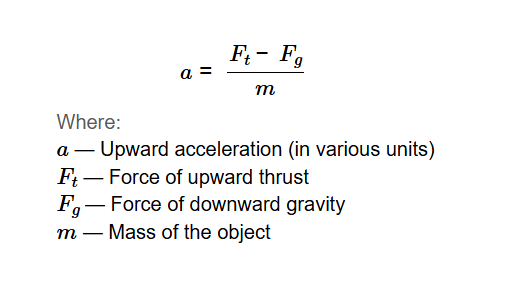 Home
Home
 Back
Back

Definition: This calculator computes the upward acceleration (\( a \)) of an object based on the net force from upward thrust (\( F_t \)) and downward gravity (\( F_g \)) divided by its mass (\( m \)).
Purpose: It is used in physics and engineering to determine the acceleration of an object due to thrust or lift, applicable in aerospace, rocketry, and vehicle dynamics.
The calculator uses the relationship:
Where:
Explanation: Enter the force of upward thrust, force of downward gravity, and mass in the chosen units, and the calculator computes the upward acceleration. Results are displayed with 5 decimal places, using scientific notation if the value exceeds 100,000 or is less than 0.0001. For default inputs (\( F_t = 20 \, \text{N} \), \( F_g = 10 \, \text{N} \), \( m = 1 \, \text{kg} \)), the calculated acceleration \( a \) is 10.00000 m/s².
Details: Calculating upward acceleration from thrust or lift is essential for designing and analyzing the performance of aircraft, rockets, and other lifting systems.
How do I find the upward acceleration from thrust or lift?
Measure the force of upward thrust, force of downward gravity, and mass in newtons and kilograms, respectively. Compute the acceleration using the formula \( a = \frac{F_t - F_g}{m} \). The result will be in meters/second².
What does upward acceleration represent?
Upward acceleration represents the net acceleration of an object in the upward direction due to the difference between the thrust force and the gravitational force divided by the mass.
What is the formula for upward acceleration from thrust or lift?
The formula for upward acceleration from thrust or lift is \( a = \frac{F_t - F_g}{m} \), where \( F_t \) is the force of upward thrust, \( F_g \) is the force of downward gravity, and \( m \) is the mass. The standard unit for acceleration is meters/second² (m/s²).